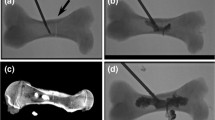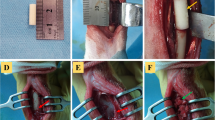Abstract
Purpose
This study was designed to compare the strength among bone marrow nails created to treat long bone fractures using interventional procedures.
Methods
Twelve resected intact tibiae of healthy swine were used. A circumferential bone fracture was made in nine tibiae and restored with the following created bone marrow nails: acrylic cement alone (ACA) (n = 3), acrylic-cement–filled bare metallic stent (AC-FBMS) (n = 3), and acrylic-cement–filled covered metallic (AC-FCMS) stent (n = 3). The remaining intact tibiae (n = 3) were used as controls.
Results
A bone marrow nail was successfully achieved within 30 min in all swine. The maximum injection volume of acrylic cement for creating ACA, AC-FBMS, and AC-FCMS was 1.7 ± 0.3, 3.2 ± 0.4, and 2.9 ± 0.4 mL, respectively. The thickness of bone marrow nail created in the ACA, AC-FBMS, and AC-FCMS groups was 3.6 ± 1.0, 10.3 ± 0.26, and 9.6 ± 0.32 mm, respectively (AC-FBMS group versus AC-FCMS group, p = 0.038), probably because of leakage of acrylic cement surrounding the interstices. The maximum bending power (kilonewton) and bending strength (newton/mm2) in the normal long bone, ACA, AC-FBMS, and AC-FCMS groups were: 1.70 ± 0.25 and 79.2 ± 16.1; 0.21 ± 0.11 and 8.8 ± 2.8; 0.46 ± 0.06 and 18.2 ± 1.6; and 0.18 ± 0.04 and 7.8 ± 2.7, respectively.
Conclusions
Although the maximum bending power and bending strength of AC-FBMS were not satisfactory, it was the most robust of the three marrow nails for restoring fractured long bone.







Similar content being viewed by others
References
Friedl W (1990) Indication, management and results of surgical therapy for pathological fractures in patients with bone metastases. Eur J Surg Oncol 16:380–396
Ingman AM, Waters DA (1994) Locked intramedullary nailing of humeral shaft fractures. J Bone Joint Surg 76:23–29
Dijkstra S, Stapert J, Boxma H et al (1996) Treatment of pathological fractures of the humeral shaft due to bone metastases: a comparison of intramedullary locking nail and plate osteosynthesis with adjunctive bone cement. Eur J Surg Oncol 22:621–626
Simon P, Jobard D, Bistour L et al (1999) Complications of Marchetti locked nailing for humeral shaft fractures. Int Orthop 23:320–324
Bauze AJ, Clayer MT (2003) Treatment of pathological fractures of the humerus with a locked intramedullary nail. J Orthop Surg 11:34–37
Vlahovic T, Bumci I (2002) Biomechanical evaluation of the value of osteosynthesis in supracondylar fracture of the humerus using Kirschner pins in children. Eur J Pediatr Surg 12:410–415
Kawai N, Sato M, Iwamoto T et al (2007) Percutaneous osteoplasty with use of a cement-filled catheter for a pathologic fracture of the humerus. J Vasc Interv Radiol 18:805–809
Nakata K, Kawai N, Sato M et al (2010) Percutaneous osteoplasty with a bone marrow nail for fractures of long bones—experimental study. J Vasc Interv Radiol 21:1436–1441
Conflict of interest
None.
Author information
Authors and Affiliations
Corresponding author
Rights and permissions
About this article
Cite this article
Nakata, K., Kawai, N., Sato, M. et al. Bone Marrow Nails Created by Percutaneous Osteoplasty for Long Bone Fracture: Comparisons Among Acrylic Cement Alone, Acrylic-Cement–Filled Bare Metallic Stent, and Acrylic-Cement–Filled Covered Metallic Stent. Cardiovasc Intervent Radiol 34, 609–614 (2011). https://doi.org/10.1007/s00270-010-9999-3
Received:
Accepted:
Published:
Issue Date:
DOI: https://doi.org/10.1007/s00270-010-9999-3




